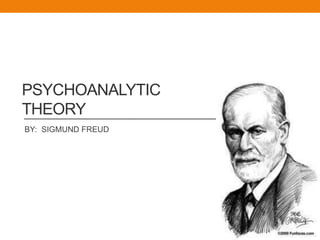
Psychoanalytic theory, BY: SIGMUND FREUD
- 2. OVERVIEW OF PSYCHOANALYSIS • MAY 6, 1856 – SIGMUND FREUD WAS BORN IN • FREYBERG TOWN, CRECH REPUBLIC • 1881 – HE GRADUATED FROM MEDICAL FACULTY, • UNIVERSITY OF VIENNA • 1896 – SIGMUND FREUD WAS OFFICIALLY RECOGNIZED • 1900 – HE RELEASED ‘INTERPRETATION OF DREAMS’ • SEPTEMBER 23, 1939 –FREUD PASSED AWAY IN HAMPSTEAD HOUSE
- 3. OVERVIEW OF PSYCHOANALYSIS A set of philosophical of human nature Psychoanalysis is both an approach to therapy and a theory of personality Emphasizes unconscious motivation – the main cause of behavior lie in unconscious mind
- 4. VIEW OF HUMAN NATURE 1.DETERMINISTIC • Life is about gaining pleasure and avoiding pain 2. HUMAN AS ENERGY SYSTEM • Freud believe that human are motivated by the unconscious, where the Id is found along with the aggression and sex instincts
- 5. PSYCHOSEXUAL STAGES • Children progress through SIX psychosexual stages during psychosexual development • A person become ‘FIXATED’ or stuck in a stage when a basic need is not met, therefore that person will face difficulty in transiting to another stage
- 6. PSYCHOSEXUAL STAGES ORAL STAGE ANALSTAGE PHALLICSTAGE LATENCY STAGE GENITAL STAGE
- 7. ORAL STAGE The first stage of development where libido is centered in a baby’s mouth. It gets much satisfaction from putting all sort of things in its mouth to satisfy libido, and thus demands. At this stage in life are oral, or mouth oriented, such as sucking, biting, and breast-feeding. (birth to 18 months)
- 8. ORAL STAGE Too much or to little satisfaction can lead to an Oral Fixation activities. This type of personality may be oral receptive, that is, have a stronger tendency to smoke, drink alcohol, overeat, or oral aggressive. As a result these person may lack of self confidence. On the other hand, the y may also fight these tendencies and become pessimistic and aggressive in relating with people
- 9. ANAL STAGE The libido now becomes focused on the anus and the child derives great pleasure from defecating. The child is now fully aware that they are a person in their own right and that their wishes can bring them into conflict with the demands of the outside world. (18 months to 3 years)
- 10. ANAL STAGE Child favorite word might be “No!”. There fore a struggle might exist in the toilet training. Fixation during this stage can result in being anal retentive, an obsession with cleanliness, perfection, and control; anal expulsive where the person may become messy and disorganized.
- 11. PHALIC STAGE It's during the stage that sexual urges remain repressed. The children’s focus is the acquisition of physical and academic skills. Boys usually relate more with boys and girls during this stage (ages 6 to puberty)
- 12. PHALIC STAGE Freud studies led him to believed that during this stage boys develop unconscious desire for their mother and consider their father as rival for her mother affection. The feelings comprise what Freud called Oedipus Complex (Oedipus unintentionally killed his father and married his mother). Psychoanalysts also believed that girls may also have similar experience toward their father, referred to as the Electra Complex.
- 13. PHALIC STAGE A fixation at this stage could result in sexual deviancies (both overindulging and avoidance) and weak with girls during this stage.
- 14. GENITAL STAGE The fifth stage of psychosexual development begins at the start of puberty when sexual urges are once again awakened. In the earlier stages, adolescent focus their sexual urges towards the opposite sex peers, with the pleasure centered on the genitals (puberty onward)
- 15. STRUCTURE OF PERSONALITY Frued described the personality structure as having three components, the ID, the EGO and the SUPEREGO. For each person, the first to emerge is the id, followed by the ego, and last to develop is the superego. ID SUPEREGO EGO One’s Personal ity
- 16. Id Infants are born with Id intact Operates on PLEASURE PRINCIPLE to gain pleasure, avoid pain. Nothing else matters to the id except the satisfaction of its own needs. It is not oriented toward considering the reality nor the needs of others.
- 17. Ego • The rational level of personality • Operates on REALITY PRINCIPLES does realistic and logical thinking • The balance between Id and Superego
- 18. Superego Partially unconscious Operates on MORAL PRINCIPLES Able to differentiate between good and bad, right and wrong If people follow their superego, they will feel proud but if they don’t follow, they will feel guilty and anxious
- 19. Example: I want to eat chocolate! Eats a small bar of chocolate I am on a super diet! ID EGO SUPEREGO
- 20. Topographical Model The unconscious. Frued said that most what we go through in our lives, emotion, beliefs, feelings, and impulses deep within are not available to us at a conscious level. He believed that most of what influence us is our unconscious. (E.g. Slip of tongue, dreams, wishes)
- 21. Topographical Model The Conscious. Frued said that all we are aware of is stored in our conscious mind. Comprises a very small part of who we are. The Subconscious. Frued said that most what we go through in our lives, emotion, beliefs, feelings, and impulses deep within are not available to us at a conscious level. He believed that most of what influence us is our unconscious.
- 22. Conscious Nonconscious Preconscious Superego Ego* Unconscious Id *Note: Ego is free floating in all three level Frued’s Conception of the Human Psyche (The Iceberge Metaphor)
